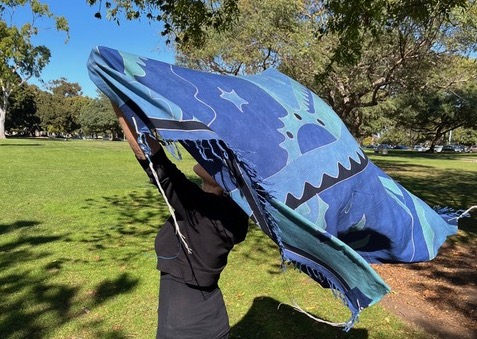This is the Ritual:
Bowing during the morning blessings.
I used to refuse to bend my knee
and bow
during the Morning Blessings.
Barukh Atah Etcetera
Thank you for Etecetera….
Who was I bowing to?
A male king?
That’s not God.
Screw that.
But then I thought
What if I bowed anyway?
What would that feel like?
So I tried it for a month.
As an interesting experiment
I bowed deeply for a month.
And
It was mechanical, pointless.
And then one day, kind of without warning
Each time I bowed, I found there was a reason.
I bowed to history and tradition,
I bowed because my ancestors bowed.
I bowed to everyone who has ever been forced to bow,
I bowed because everyone else in the room was bowing.
I bowed to my fear of the future,
I bowed to my regrets of the past.
I bowed because I am not the center of the universe.
I bowed because I do feel God’s presence, somehow.
This is the Ritual:
Wearing a tallit.
I never wore a tallis
During the Shabbat morning service
When I was little
It’s cause I was a girl
Girls didn’t do that
I sat next to my Daddy in services and played with his tallis fringes
But they were his, not mine,
Never to be mine.
And anyway, why should I?
Do I really think God cares whether I wear fringes?
Do I even believe in the kind of God who would care if I wore a frigging shawl?
I don’t believe in religious rules!
I can wear whatever I want!
How dare you tell me how to be a Jew!!
And anyway, navy blue stripes,
So boring.
Everybody knows
I’m all about the fashion accessories,
So screw that
But then I thought,
What if I wore a tallis anyway?
What would it feel like?
So I wore it for a month,
As an interesting experiment.
And
It was dramatic and self-aggrandizing, look at me.
And then one day, kind of without warning,
Each time I put on my tallit I found there was a reason.
I put on the tallit because it was winter and it kept me warm.
I put on the tallit to wrap myself in the memory of my father, sometimes I even wore his.
I put on the tallit because I can and you can’t stop me.
I put on the tallit because it covered the vanity of whatever I was wearing that day.
I put on the tallit because I found one that matched my outfit.
I put on the tallit because it draped me in Torah.
I put on the tallit because God apparently has a thing for fringes and who am I to argue?
I put on the tallit because women who wear tallit at the Kotel, the Wailing Wall, get arrested by the state of Israel.
This is the Ritual:
Wearing a kippah.
I sometimes wore a yarmulke when I was young
The flimsy lacy kind.
Stuck on with a bobby pin,
A trivial thing,
A girly affectation,
Stupid.
A real kippah was for boys,
It fit their short hair.
But it flattened my lovely curls
So screw that.
But then I thought
What if I wore a kippah anyway?
What would it feel like?
So I wore a kippah on my head for a month,
As an interesting experiment.
Immediately, each time I put on my kippah,
I found there was a reason.
And it was amazing!
I put on my kippah to make a feminist statement.
I put on my kippah because it shows respect for the synagogue and the prayer leaders.
I put on my kippah to announce to myself that I have entered the shul and I must be mindful.
I put on my kippah because I can have a lot of different ones to match my moods and my earrings.
I put on my kippah because everything underneath becomes a capsule of kadosh, of holiness.
I put on my kippah because it reminds me to connect to God, however I understand God that day.
These are the rituals:
When I thank a being I don’t believe in at least in the old way
Except when I do,
When I need something bigger than myself,
I bow.
When I go to services
And I need to separate myself from the mundane
But not my community,
I wrap myself in my tallit.
When I begin another vertical conversation with the non-linear
And I need to place myself in kesher, connection,
I put on my hat of holy, my kippah.
Berukhah At Achat, Barukh Atah Ekhad, Bless the One-ness, giving us the ability to make interesting experiments, encircling time and space with meaning.
Amen.











